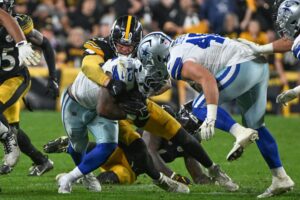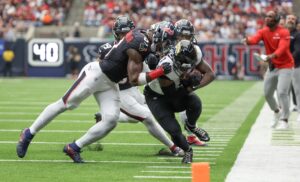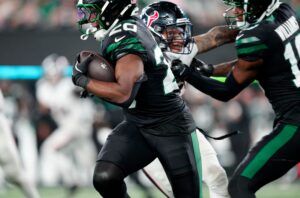A common nuance among the NFL is the term “getting exposed,” applied appropriately to teams whose offense has fundamentally been broken after an enticing start. The Kansas City Chiefs currently stand in this category due to their consistency to relying on the run to set up motions and primary sets. Thus, the common application for these “exposed” offenses is to fundamentally “fix” with a dramatic switch in leaders, positions, or personnel.
However, with the Chiefs and Andy Reid, the “fix” for 2017 will not be in personnel or a dramatic situation. Reid runs a stable, legacy built culture – dramatic shifts are reserved for breaking and reformatting in the off-season. Hence, the 2017 tweaks in the offense will rely on transitions and reevaluating the timing of play calling and package insertion.
The Chiefs call a pacing offense where each formation is a precept for the next; the inevitable tweaks and adjustments will be difficult to observe by looking at the meta. The Kansas City Chiefs week 13 scheme will beget the same offense and defense, but a different pacing to assert manipulation of the New York Jets scheme.
Kansas City Chiefs Week 13 Scheme Breakdown – Manipulating Through Pacing
A Change of Pace
The Chiefs offensive scheme in week 13 is more about resolving their own problems than beating the Jets. As staunch and prideful as that sounds, the underlying notion is a Chiefs team that could quickly lose control of their season and enter every game desperate. Alex Smith is rarely a desperate quarterback, but threw a desperate pass to Tre’Davious White of the Buffalo Bills to clinch last week’s loss. The pressure at the end of the game was clearly compounding upon everyone.
Mitigating that pressure begins by getting ahead early, and maintaining that lead. As boring and painful the offense can be, the Chiefs statistically perform smoother when managing a lead. (Discussing the long-term ramifications of a managerial offense is reserved for a full-length feature.) Without a lead, the Chiefs will conform to pressure, creating interceptions and a defunct run game.
The New York Jets defense is young, wildly inconsistent, but a part of the definition of inconsistent is occasional electricity, specifically from the Jets backfield. In the NFL Draft, the Jets chose to contrast their secondary by drafting Marcus Maye and Jamal Adams. The two young safeties are mistake prone, but complement each other.
Adams is a more proficient compass safety, but tends to play better upward in the box. Maye is a better finesse safety, playing proficient zone. Naturally, the more they have played through 2017, the communication and recognition have improved. Utilizing three safety sets, the Jets can efficiently run a plethora of coverages. This includes disguises and shadowing for 10 interceptions on the season, of which Maye has two.
The onus of the middle field is owned by Adams. Not only is he athletic, but predominantly strong, with two sacks on delayed blitzes. If a disguise is run correctly, Adams can cheat up on the field compass and cause short-yardage havoc.
The Jets potential to guard the short zones of the field will demand precision from Smith. Notably, this is where Kareem Hunt thrives in passes as an extension of the run game. The last several opponents have maintained cover two against the Chiefs to not only negate Hunt at the point of reception, but also takeaway the threat of Travis Kelce deep.
The cover two look certainly will be the hinge point for the Jets to run from, demanding Hunt either burn with agility and speed or spend the rest of his afternoon wallowing with one-yard receptions. The importance of the short passing game is further emphasized due to the Kelce problem. When Hunt or Tyreek Hill begin efficiently destroying the middle field, safeties cheat up, break true cover two, which creates an open lane for Kelce.
Focusing on the pass game first is due to the proficiency it begets. The Chiefs move up field on the run, but chunk away yards on their long drives by opting to frustrating defenses with passes. Moving to the Chiefs hinge point, it begins with the offensive lane creating more screen lanes, protecting Smith, and opening windows for Hunt.
Todd Bowles runs several fronts throughout the game, although they have not been intrinsically successful. Ideally, the Jets will use their front defensive tackles Muhammad Wilkerson and Leonard Williams to create chaos, allowing Demario Davis and Darron Lee free on blitz schemes that bear creativity from the up-front shifts. For a switch in momentum, however, Bowles will also call linebacker blitzes and use those to free up his defensive tackles. Hence, the pass rush focus is on every defensive player at any given moment.
Fortunately for many opponents of the Jets, when the blitz packages are picked up, the secondary begins to fall apart. More talented wide receivers can pierce the Jets secondary come the fourth quarter. This is a primary reason the Jets have lost so many early leads.
Unfortunately for the Chiefs, they do not own a technical receiver. Demarcus Robinson may see more under routes and an increase in targets on third down, but he has yet to show overt technical procedures for more evolved concepts.
Thus, the offensive answer is two-fold. First, Hill lined up as a wide receiver (upon breaking the Jets cover two) will utilize his superior speed to take advantage of the Jets one-on-one coverage emphasis. This falls back to the idea Reid will not change the personnel, but change the timing of the personnel to create organized mismatches.
The second nuance comes in the screen game. One of the ways to break the cover two is utilizing more routes to the flat for Kelce and Charcandrick West. Although West is not the overt athlete of the Chiefs offense, churning pass after pass to him at the right time can draw up safeties and linebackers to break the deep zone.
Further, if tight end Jimmy Graham is studied in detail, his time with Drew Brees and now Russell Wilson has proven better results when he is fed the ball in short yardage situations. Kelce has similar proportions and skills to Graham. If Smith and Kelce connected on a repeated motion, akin to how a big running back needs to be fed, then the Jets are set for an exhausting afternoon of defending from a violent football player.
Fit-To-Run
Last week saw a profound change of pace on the defense in the fit-to-run operation Reggie Ragland and Daniel Sorensen played with. Granted the Buffalo Bills operated out of a managing offense, opting for field goals and not risking intrinsic explosive plays. No matter, the fit-to-run was exceptional as LeSean McCoy was held to two explosive runs.
The Chiefs defense needs to see Ragland, Sorensen, and Ron Parker continue to take the lead in their respective role. Ragland provides a youthful juxtaposition to the slowing Derrick Johnson, while Sorensen can play a box safety moving with aggression. Parker will need to settle into assisting in deep zones, now aided by Darrelle Revis.
In synthesis, the defense ought to be intelligent, playing their respective roles not only for themselves, but with an aggressive demeanor for the man next to them. Ideally, the Jets operate out of multiple wide-formation receivers to spread defenses out and create mismatches. Their onus is on getting functional targets (the tight end and running back) open by utilizing long receiver sets.
Josh McCown’s decision-making is the foremost hinge point of the Jets offense under coordinator John Morton. Wide receivers Robby Anderson and Jermaine Kearse can run either quick slants, under routes, or extend over the top of a defense. During those extended plays, Morton uses tight end Austin Seferian-Jenkins or one of his running backs to draw linebackers and safeties up and out with split sets. When a certain defender is drawn upward, that unleashes Anderson and Kearse in the seam. Hence, the offense is built upon taking opportunity of mismatches.
The running game is a mixed bag of success and failure. In some games, Bilal Powell has punished teams, while in others, the running game has been a glorified brick wall. The key point is on how linebackers fit-to-run and adjust to motions. If the offense is experiencing success, then linebackers are spread out, leaving open lanes for a counter or draw run.
Since the Jets operate out of the same sets in both pass and run plays, the aforementioned intelligence becomes essential for the Chiefs to stop the Jets offense. Elijah McGuire is a young running back who has seen more carries in the past weeks due to his explosive agility – or, a recipe for gashing the Chiefs defense.
Ragland will take responsibility for beating the run by playing with the same run-to-fit he did last week. Sorensen will need to efficiently communicate and disseminate between a run, a quick screen or flat pass. The Jets utilize Powell and Matt Forte as essential passing targets in the flat and screen game, extensions of the run game. Those could quickly turn into explosive plays unless the Chiefs recognize what is happening.
McCown may not be the statistical wonder at quarterback, but he can target receivers with proficiency when given the chance. Revis ought to help in the zone by shadowing across from Marcus Peters. Anderson is the more athletic receiver, while Kearse is the physical specimen relying on hand-to-hand combat to get open. Therefore, Revis ideally would be fit to cover Kearse, and Peters to blanket Anderson.
The short passing game to the flats will put an onus on Parker and Sorensen blasting Seferian-Jenkins upon receipt. He is especially dangerous in the red zone, which implicates the Chiefs bending should come rarely. If one of the Jets players get loose in the red zone, they may be scoring more touchdowns than mere field goals.
The 35 sacks the Jets have suffered ought to be noted. If the Chiefs are poignant, Justin Houston and one of the other touted pass rushers (whomever is healthy) should be able to stop McCown from seeing the field clearly, creating a poor screen pass for one of the linebackers to intercept.
Summarizing the Plan of Attack
The Chiefs offense has the responsibility of spreading out the corners and piercing them with Hill down the sideline. Utilizing Kelce and West repeatedly on the short sidelines will be the best opportunity to create a mismatch epitomizing Smith’s managerial excellence and the Jets oft flat second half defense. However, both of those ideals are precedent on Reid subtly changing the timing of his play calls to introduce unprecedent mismatches and force disorganization.
Playing proper fit-to-run will stop the Jets from having tenured success. McCown is proficient at moving the ball in small chunks and has displayed the ability to go deep by spreading defenses out. The short game can be particularly dangerous for a Chiefs team caught in over-pursuit and confusion. Ragland, Parker, Sorensen, and Revis all need to communicate and spot the true nature of the play. Staying on assignment will prevent the Jets from eclipsing the ‘break’ in the “bend but don’t break” philosophy.
Main Image:






